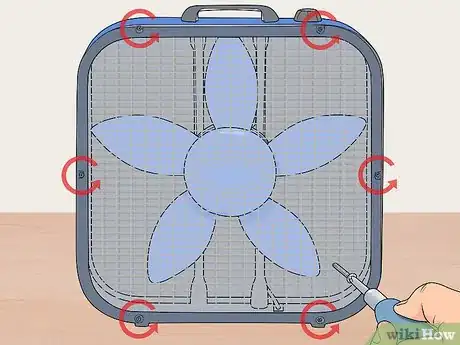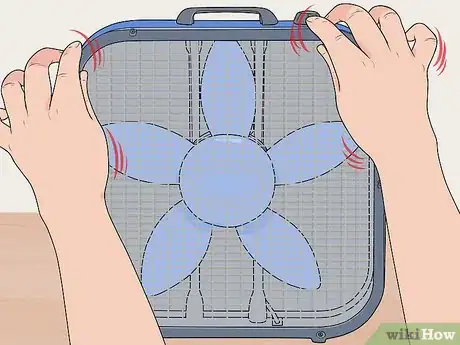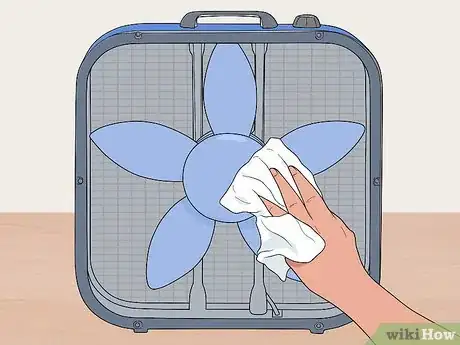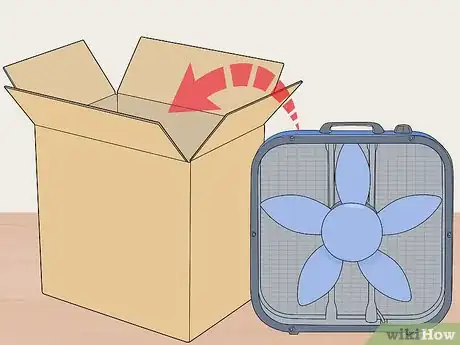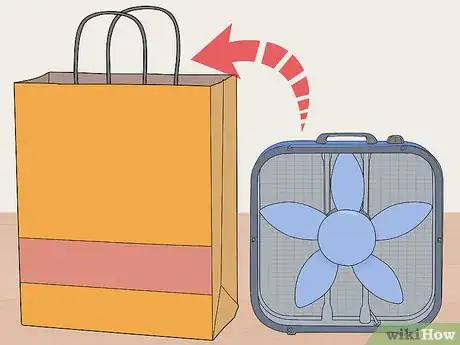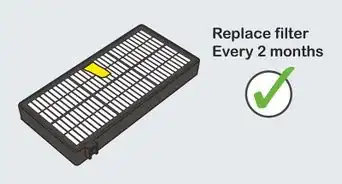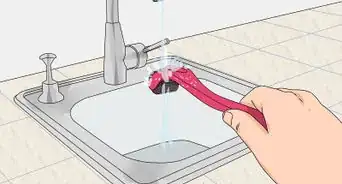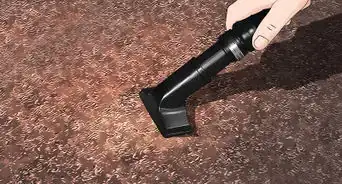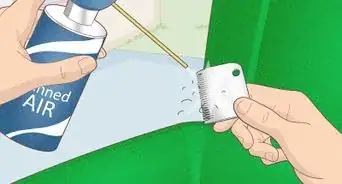This article was co-authored by Michelle Driscoll, MPH. Michelle Driscoll is the Owner of Mulberry Maids, which is based in Fort Collins, Colorado. With five years of experience, her business specializes in cleaning homes and small offices. She holds a Masters in Public Health from the Colorado School of Public Health. Additionally, Mulberry Maids has an A+ rating from the Better Business Bureau.
There are 7 references cited in this article, which can be found at the bottom of the page.
This article has been viewed 90,926 times.
A box fan can be a lifesaver during the warm spring and hot summer months. It pushes away the heat and provides the house with cool air while reducing your energy bills a little. It’s also an economically sound investment that often gets overlooked in maintenance. However, these fans collect dust over a short window of time and start becoming less effective at keeping the house cool. This dust can also affect the air quality in your home. Homeowners typically throw these fans away instead of doing what it takes to preserve them. It isn’t necessary to replace your old box fan with a new one. Instead, do the work to make them look and act new again.
Steps
Cleaning the Box Fan
-
1Unplug the box fan. Wipe down the power cord with a damp cloth. Make sure to dry it. Set the fan itself on a waist level work area, like a bench or a kitchen table.[1]
-
2Remove the outer covers of the fan. Unscrew the screw securing both grilles to the metal box frame and remove them. Place the screws in a plastic baggie for later to ensure the screws don’t get lost.[2]Advertisement
-
3Clean the outer covers of the fan. Use your bathtub as a method to clean the covers. Plug the drain to your tub and add enough water to soak them in. When the dust and dirt comes off easily with a rinse, the covers are finished soaking.[3]
- An alternative method is dousing the covers down with some vinegar. If you have a hose outside, use that to hose off your covers. The dirt will come right off.[4]
- It’s slightly harder to clean the covers by hand, but it can be done that way as well. Spray the covers with equal parts water and vinegar, and then wipe the dirt away with a towel.[5]
-
4Spray and wipe down the blades to clean them. You can either use the towel you already dampened with vinegar and water, or apply vinegar and water to a dry towel. Be careful to avoid spraying directly onto the blades. Instead, apply it to the cloth and then wipe the blades with the dampened cloth. Apply pulling pressure to the blade set and remove it if needed.[6]
- Use a vacuum with the hose attachment to vacuum out the motor vents.
- You can also use mild dish soap mixed with water and use a q-tip to help you clean out hard to reach areas.[7] Take care not to get any water or cleaning agents in the motor, however, since this can cause damage.
- Gently wipe down all plastic parts, like the outside of the fan, its carrying handle, and its knobs, with a damp cloth.
-
5Reassemble the box fan. Be sure that all the parts are thoroughly dry before reassembling. Apply pushing pressure to the blade set and knock it back on gently with a hammer. Secure both plastic grilles and use the screws you removed earlier to screw it back into place. Put on the plastic speed control dial knob.[8]
Maintaining the Box Fan
-
1Buy an air filter for your fan. You can help prevent a buildup of dust and grime on your fan by attaching an air filter to it. Look for a filter that is designed to fit the size and shape of your box fan online or in a home supply store. Make sure to attach the filter to the rear part of your fan, where the air is drawn in.
- If you like, you can also construct your own DIY filter and attach it to the front of your fan, allowing it to do double-duty as an air purifier.
- For example, if you have a 20 in (51 cm) box fan, purchase a 20 in (51 cm) by 20 in (51 cm) MERV 11 furnace filter and attach it to the front of your fan with some heavy-duty tape.
-
2Clean fan blades of accumulated dirt regularly. Accrued dirt on fan blades cause bearings to become worn out, which creates a lot of noise from the fan. Every 2 weeks, you should vacuum the fan with the crevice-cleaning hose attachment. Wipe down the blades with a damp sponge twice a summer.[9]
- In addition to causing damage to the fan, dust and dirt built up on the blades can blow into your home, reducing the air quality inside.
-
3Inspect the box fan to make sure that there are no loose external parts. Box fans do an amazing job keeping the house cool, but oftentimes they also cause a lot of noise. Look for looseness in the fan’s housing and fan guards.[10]
-
4Disassemble the box fan to see if there are any loose internal fasteners if the problem persists. Inspect blades to make sure there aren’t any cracks, and replace them as necessary. Screw the spinner further into place and tighten it if it seems too loose. This will tighten the fan hub to the shaft and simultaneously secure the spinner into place.[13]
-
5Quiet any rattling the box fan might make. If you notice that the box fan makes noise on level or smooth surfaces instead of on cushioned surfaces, it might be an issue with its base. Pads might be missing, so inspect the base of the fan and replace its pads as needed.[14]
Storing the Box Fan
-
1Give your fan a deep cleaning. During the spring and summer months, your home might need the extra coolness a box fan provides. At the change of the season, maintain the fan and prepare it properly by cleaning it before you store it. Disassemble it, soak it, wipe it down, and reassemble it.[15]
-
2Prevent dust from settling on your fan by putting it in storage. Cover the box fan for the fall and/or winter season to keep it clean, pristine, and ready for use when the weather warms up again.[16]
-
3Use a brown bag or trash bag to store the box fan. Cut a shape that fits perfectly over the sides of the box fan covers to shield it from dust and dirt. Tape the bag into place over the fan or tie around it with a thin cord. Now put it away until spring.[17]
Community Q&A
-
QuestionHow to get gunk out of the fan motor, so I can lube it properly and not have the oil mix with the gunk and form a glue like substance that makes the situation worse?
 Community AnswerVacuuming while brushing with a toothbrush will get most of it or you can also blow most of it out with a straw, a small diameter hose or a can of compressed air.
Community AnswerVacuuming while brushing with a toothbrush will get most of it or you can also blow most of it out with a straw, a small diameter hose or a can of compressed air.
Things You'll Need
- Box fan
- Plastic Baggie
- Philips Head Screwdriver
- 2 Cloths
- Spray bottle, ½ water, ½ vinegar
- Hammer
- Trash bag or brown paper bag
- Tape or thin cord
- Silicone sealant
- Cardboard
References
- ↑ http://www.apartmenttherapy.com/how-to-clean-store-a-box-fan-f-132097
- ↑ http://www.apartmenttherapy.com/how-to-clean-store-a-box-fan-f-132097
- ↑ http://www.apartmenttherapy.com/how-to-clean-store-a-box-fan-f-132097
- ↑ http://www.apartmenttherapy.com/how-to-clean-store-a-box-fan-f-132097
- ↑ http://www.apartmenttherapy.com/how-to-clean-store-a-box-fan-f-132097
- ↑ http://www.apartmenttherapy.com/how-to-clean-store-a-box-fan-f-132097
- ↑ http://www.huffingtonpost.com/2012/06/08/how-to-clean-fan_n_1578777.html
- ↑ http://www.apartmenttherapy.com/how-to-clean-store-a-box-fan-f-132097
- ↑ http://articles.latimes.com/1998/aug/08/home/hm-11069
- ↑ http://articles.latimes.com/1998/aug/08/home/hm-11069
- ↑ http://articles.latimes.com/1998/aug/08/home/hm-11069
- ↑ http://articles.latimes.com/1998/aug/08/home/hm-11069
- ↑ http://articles.latimes.com/1998/aug/08/home/hm-11069
- ↑ http://articles.latimes.com/1998/aug/08/home/hm-11069
- ↑ http://www.apartmenttherapy.com/how-to-clean-store-a-box-fan-f-132097
- ↑ http://www.apartmenttherapy.com/how-to-clean-store-a-box-fan-f-132097
- ↑ http://www.apartmenttherapy.com/how-to-clean-store-a-box-fan-f-132097
- Videos provided by allevandavies
About This Article
To clean a box fan, start by unplugging the fan so it doesn't turn on when you're cleaning it. Then, unscrew and remove the outer covers of the fan, and soak them in a tub or sink filled with water. Next, while the covers are soaking, wipe down the blades of the fan with a vinegar and water mixture, and use a vacuum hose attachment to clean out the motor vents. You can also use a q-tip soaked in soapy water to clean hard-to-reach spots. Finally, dry all of the components before reassembling the box fan. To learn how to maintain a box fan so it stays cleaner for longer, scroll down!

